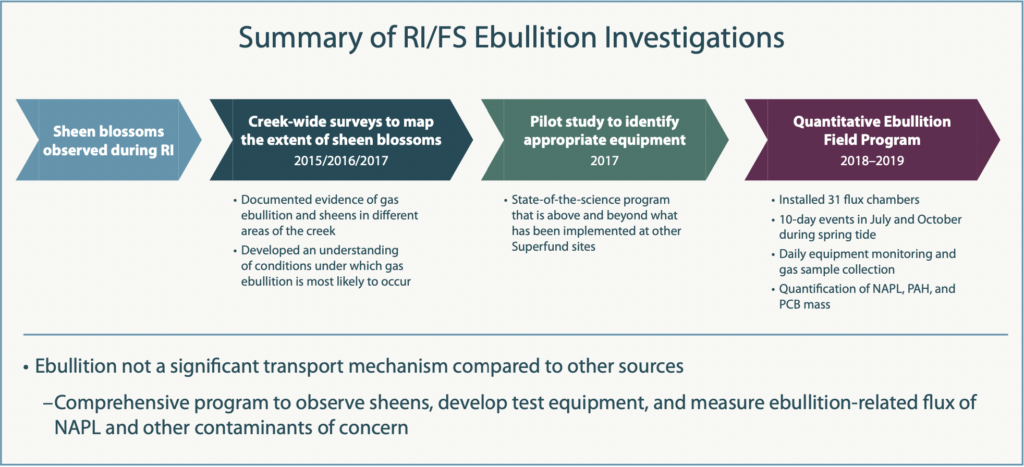Fact Sheet #5
Understanding the Origins and Significance of Ebullition
at Newtown Creek Superfund Site
Background Information
The Superfund program develops remedies at contaminated sites to reduce risks to human health and the environment. The EPA designated Newtown Creek a Superfund site and oversees, reviews, and approves all work conducted at the site and will decide what remedies are required. The Superfund process requires the collection of detailed environmental data to enable understanding of the system and contaminants. A conceptual site model (CSM) is a way to compile all collected information and link it together in a way that provides a comprehensive understanding of the Site and assists in the development of appropriate remedial options for the Site. Below is a figure illustrating the CSM for Newtown Creek.

The CSM figure shows the primary processes of how contaminants enter and leave the system. This includes particles and water that move into and out of the Creek. The focus of this Superfund Site is the sediments at the bottom of the creek. The primary sources of particles, water, and contaminants into Newtown Creek are the East River, New York City sewers and street storm drains, and stormwater runoff from properties surrounding the creek. Another process that moves a small amount of contaminants from the sediments to surface water is a process known as ebullition (see highlighted green square on the figure). This fact sheet will explore this process.
Definition of Ebullition
Ebullition is the process by which gas bubbles of mainly methane and carbon dioxide are created in the shallow sediments of a waterway, and subsequently make their way through the sediment to the overlying water when physical conditions are favorable. These bubbles are produced by microbial activity that occurs when there is excess organic matter in the sediment that is broken down by bacteria. If the physical conditions are right and there is sufficient gas, the bubbles can move through the sediment to the water column. Ebullition is most prevalent in summer months (warmer sediment temperatures drive higher rates of microbial activity) and under low tide conditions (when pressure in the sediment is decreased, allowing the bubbles to move through the sediment more easily).
When a gas bubble forms in the sediment where Non-Aqueous Phase Liquid (NAPL) (liquid organic compounds that do not dissolve in or easily mix with water), such as oil, gasoline, and petroleum products are present, NAPL can coat the gas bubble. Similarly, when a gas bubble forms within the sediment where no NAPL is present, but the gas bubble passes through a layer of sediment containing NAPL, NAPL can coat the gas bubble. In either case, the NAPL-coated gas bubble could enter the water column and rise to the surface. There, the gas bubble would burst and a sheen blossom (i.e., a thin layer of NAPL) would form. The resulting sheen will dissipate over time.
Ebullition in Newtown Creek
Ebullition occurs in Newtown Creek. For the Superfund sediment remedy, investigators had to determine if the volume of contaminants transported by ebullition is a significant source of contamination to Newtown Creek and if it could cause the remedy to fail. After eight years of progressively more significant study, the resulting data revealed that ebullition is not a significant transporter of contaminants. Remedies such as sediment capping, if selected by EPA, could be engineered to address ebullition concerns.
Contaminant Loading from Ebullition

This chart shows the progress of ebullition studies during the Newtown Creek Remedial Investigation/Feasibility Study (RI/FS). Ebullition in Newtown Creek has been extensively studied, quantified, and documented in the RI report and in Feasibility Study field investigation reports. These studies have demonstrated that NAPL-coated gas bubbles have a very limited contribution to contaminant loads within Newtown Creek surface water. The emergence of gas bubbles from ebullition and the formation of sheens are limited to areas with shallower water and higher concentrations of organic materials in sediment. Surveys revealed that fewer ebullition gas bubbles were observed in the first two miles of Newtown Creek’s main stem, where water is deeper, and sediment has lower organic material content. Conversely, the tributaries, including upper Dutch Kills, East Branch, and lower English Kills, exhibited some of the higher gas bubble and sheen blossom rates (Anchor QEA 2023).
The 2018/2019 Gas Ebullition Field Program concluded that ebullition does not play a significant role in transporting contaminants to the surface water. For example, in East Branch, where sheen blossoms from ebullition are sometimes observed, the estimated annual amount of polycyclic aromatic hydrocarbons (PAHs) entering the reach from ebullition-facilitated transport was 0.033 kilograms (0.073 pounds) per year. Ebullition-facilitated transport from polychlorinated biphenyls (PCBs) was only 0.002 kilograms (0.005 pounds) per year (Anchor QEA 2021). These amounts are negligible in comparison to other contamination sources to Newtown Creek and would easily be captured by a remediation strategy engineered to do so for the Newtown Creek sediment, including sediment capping or dredge-and-cap remedy alternatives.
References
Anchor QEA 2021. “Feasibility Study Gas Ebullition Data Evaluation Report”; Remedial Investigation/Feasibility Study, Newtown Creek. September.
Anchor QEA 2023. “Remedial Investigation Report”; Remedial Investigation/Feasibility Study, Newtown Creek. March.
